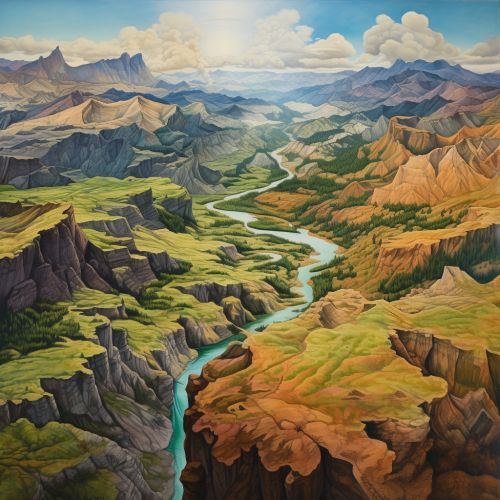Plate Tectonics and Landscape Formation
Introduction
Plate tectonics is a scientific theory that explains the large-scale movements of Earth's lithosphere. This theory was formulated in the late 1960s and early 1970s on the basis of earlier concepts of continental drift, which was first proposed by Alfred Wegener in 1912, and seafloor spreading, a hypothesis proposed by Harry Hess in 1960. Plate tectonics is a comprehensive theory that has revolutionized Earth sciences by providing a uniform context for understanding mountain-building processes, volcanoes, and earthquakes as well as the evolution of Earth's surface and reconstructing its past continents and oceans.


Theory of Plate Tectonics
The theory of plate tectonics postulates that the Earth's rigid outer layer, or lithosphere, is broken up into several large and small "plates" that move relative to one another as they ride atop the underlying, semi-fluid asthenosphere. The lithosphere includes the crust and the uppermost mantle, which constitute the hard and rigid outer layer of the Earth. The asthenosphere is part of the mantle, the middle sphere of the Earth that extends to 2900 kilometers (1800 miles) below the surface. The asthenosphere is a part of the upper mantle just below the lithosphere that is involved in plate tectonic movements and isostatic adjustments.
The driving force behind plate tectonics is convection in the mantle. Hot material near the Earth's core rises, and colder mantle rock sinks. It's kind of like a pot boiling on a stove. The heat from the core is transferred to the mantle, causing the material there to rise towards the surface, thus creating currents. These currents cause the tectonic plates to move slowly across the surface of the Earth.
Plate Boundaries
The edges where these plates move against each other are sites of intense geologic activity, such as earthquakes, volcanoes, and mountain building. Plate boundaries are commonly associated with geological events such as earthquakes and the creation of topographic features like mountains, volcanoes, mid-ocean ridges, and oceanic trenches. The majority of the world's active volcanoes occur along plate boundaries, making them crucial in the study of volcanoes and earthquakes.
There are three types of plate boundaries: divergent, convergent, and transform. Each type of boundary results in specific geological features and phenomena.
Divergent Boundaries
Divergent boundaries occur where plates move apart from each other. This happens at mid-ocean ridges. These are undersea mountain chains where new ocean floor is produced; this occurs through the process of seafloor spreading. The spreading rate varies between about 2.5 cm/year (1 inch/year) along the Mid-Atlantic Ridge to over 15 cm/year (6 inches/year) along the East Pacific Rise.
Convergent Boundaries
Convergent boundaries occur where plates move towards each other. This type of boundary often results in one of the plates being forced under the other in a process known as subduction. The subducting plate is forced to move into the mantle where it is eventually melted and recycled. This process results in a deep oceanic trench and often in volcanic activity.
Transform Boundaries
Transform boundaries occur where plates slide past each other. This type of boundary results in shear stress. Transform faults are the site of some of the world's deadliest earthquakes. The San Andreas Fault in California is an example of a transform boundary where the Pacific Plate is moving northward relative to the North American Plate.
Plate Tectonics and Landscape Formation
The movement of tectonic plates has a significant impact on the Earth's landscape. The formation of mountains, valleys, and other landscape features can be directly attributed to the shifting of these plates.
Mountain Formation
Mountain ranges are primarily formed at convergent boundaries where plates collide and the crust is forced upwards. This process, known as orogeny, can take millions of years to form significant mountain ranges. The Himalayas, for example, are still rising as the Indian Plate continues to move northward into the Eurasian Plate.
Valley Formation
Valleys are often formed as a result of erosion, which is the process of wearing down and carrying away rocks and sediments. This can occur through the action of rivers, glaciers, waves, wind, and underground water. However, valleys can also be formed through plate tectonics. Rift valleys, for example, are formed at divergent boundaries by the collapse of the land as the plates move apart.
Formation of Oceans and Seas
The formation of oceans and seas is also influenced by plate tectonics. As plates diverge at mid-ocean ridges, magma rises to fill the gap, creating new oceanic crust. This process, known as seafloor spreading, leads to the expansion of the ocean basins. Conversely, when oceanic plates converge with continental plates, the denser oceanic plate is subducted beneath the lighter continental plate, creating a deep trench. Over time, these processes can lead to the formation and alteration of oceans and seas.
